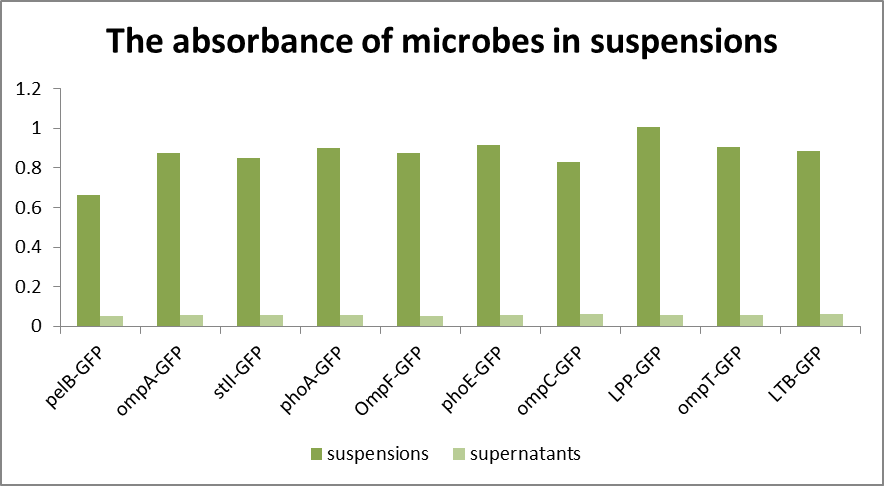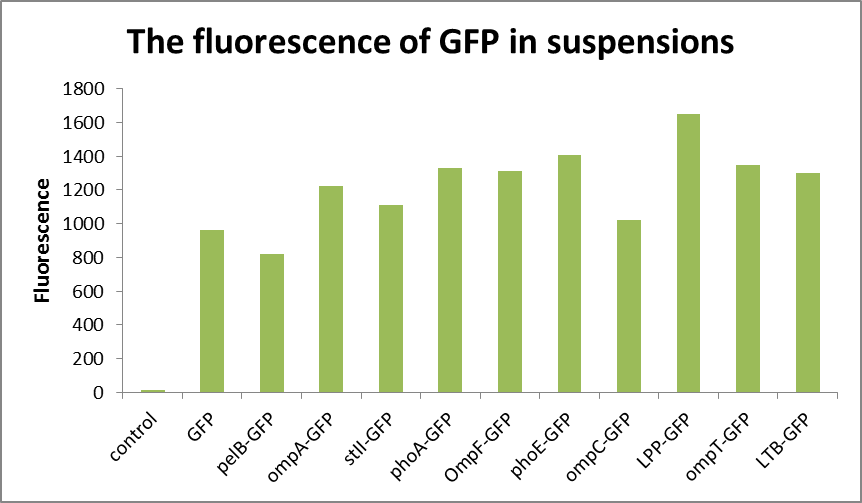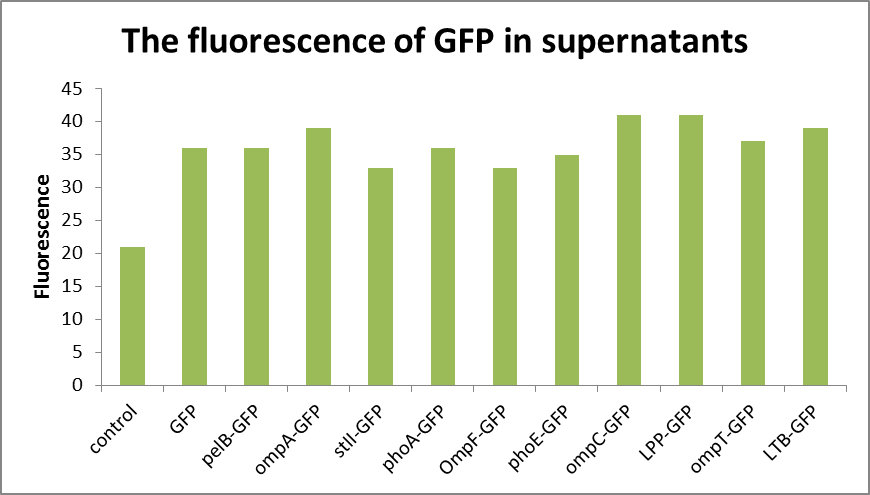Difference between revisions of "Part:BBa K2273055"
| (4 intermediate revisions by 3 users not shown) | |||
| Line 1: | Line 1: | ||
| − | |||
__NOTOC__ | __NOTOC__ | ||
| − | <partinfo>BBa_K2273055 short</partinfo> | + | ===<partinfo>BBa_K2273055 short</partinfo>=== |
| + | The PhoA signal peptide is part of the Signal Peptide Toolbox of [http://2017.igem.org/Team:TU_Dresden iGEM Team TU Dresden 2017 (EncaBcillus - It's a trap!)].<br><br> | ||
| + | The signal peptide (amino acids 1 to 31) of <i>Bacillus subtilis</i> alkaline phosphatase A (aquisition of phosphate upon phosphoate starvation, Uniprot [http://www.uniprot.org/uniprot/P19406 P19406]) targets for protein secretion via the Sec-SRP secretion pathway (Brockmeier <i>et al</i>, 2006).<br><br> | ||
| + | This part was generated in a modified version of RFC25, where a strong Shine Dalgarno Sequence (SD) is included, and has the following prefix and suffix:<br> | ||
| + | <table> | ||
| + | <tr> | ||
| + | <td width="70">Prefix with</td> | ||
| + | <td width="200"><span style="color:blue">EcoRI</span>, <span style="color:green">NotI</span>, <span style="color:red">XbaI</span> and <span style="color:silver">SD</span></td> | ||
| + | <td>5'-<span style="color:blue">GAATTC</span><span style="color:green">GCGGCCGC</span>T<span style="color:red">TCTAGA</span>T<span style="color:silver">AAGGAGG</span>TCAAAA-3'</td> | ||
| + | </tr> | ||
| + | <tr> | ||
| + | <td>Suffix with</td> | ||
| + | <td><span style="color:orange">AgeI</span>, <span style="color:red">SpeI</span>, <span style="color:green">NotI</span> and <span style="color:blue">PstI</span></td> | ||
| + | <td>5'-<span style="color:orange">ACCGGT</span><u>TAA</u>T<span style="color:red">ACTAGT</span>A<span style="color:green">GCGGCCG</span><span style="color:blue">CTGCAG</span>A-3'</td> | ||
| + | </tr> | ||
| + | </table> | ||
| + | Sites of restriction enzymes generating compatible overhangs are indicated by sharing one color. (<span style="color:blue">EcoRI</span> and <span style="color:blue">PstI</span> are marked in blue, <span style="color:green">NotI</span> in green, <span style="color:red">XbaI</span> and <span style="color:red">SpeI</span> in red and <span style="color:orange">AgeI</span> in orange. Additionally, the <span style="color:silver">Shine-Dalgarno sequence</span> is marked in silver and the stop codon is underlined.)<br><br> | ||
| + | This part is used in the 2017 TU Dresden iGEM project [http://2017.igem.org/Team:TU_Dresden EncaBcillus - It's a trap!] and part of the Signal Peptide Toolbox. <br><br> | ||
| − | + | ===Signal Peptide Toolbox=== | |
| + | The GRAM-positive model organism <i>B. subtilis</i> is considered a perfect host for heterologous and recombinant protein secretion due to its extracellular chaperones, natural protein secretion capacity and well-studied genetics (van Dijl and Hecker, 2013). To increase protein production rates of such proteins, it is feasible to enhance the secretion efficiency. The easiest method to realise this, is to tag the protein of interest with a so-called signal peptide of <i>B. subtilis</i>' general protein secretion pathway Sec-SRP which dictates the secretion of proteins into the surrounding supernatant of the cell (Fu <i>et al</i>, 2007).<br><br> | ||
| + | Though the Sec-SRP protein secretion pathway of <i>B. subtilis</i> contains more than 170 distinct signal peptides, every single signal peptide varies in its secretion efficiency in dependency on the protein fused to it. To date, it is impossible to predict this dependency via studying the genetic code of the signal peptides and the protein of interest (Brockmeier <i>et al</i>, 2006).<br><br> | ||
| + | To cope with this issue, the [http://2017.igem.org/Team:TU_Dresden iGEM team of TU Dresden 2017 (EncaBcillus - It's a trap!)] developed a novel shotgun approach high-throughput signal peptide screening vector system for targeted secretion in <i>B. subtilis</i>, or “Signal Peptide Toolbox” for short.<br><br> | ||
| + | The Signal Peptide Toolbox contains the so-called [https://parts.igem.org/Part:BBa_K2273107 Evaluation Vector] and the Signal Peptide Mix which is made of equal amounts of all signal peptides which are part of the Signal Peptide Toolbox. It can be used by any team to increase secretion efficiency of heterologous and recombinant proteins in <i>B. subtilis</i>.<br><br> | ||
| + | The iGEM team TU Dresden 2017 provides an Evaluation Vector construct with an [https://parts.igem.org/Part:BBa_K2273107 inducible promotor]. Nonetheless, the vectors' promotor can still be replaced easily.<br><br> | ||
| + | For screening, in a first step, the coding sequence of the protein of interest as well as a promotor of choice would be cloned into the Evaluation Vector. In a second step, all signal peptides of the Signal Peptide Mix would be integrated into the vector at once. Finally, the randomly transformed bacteria colonies are screened for their specific secretion efficiency using a protein of interest specific assay. Those strains, which reassemble the secretion level of choice the best, can then be sequenced to reversely identify the integrated signal peptide. This process is shown in the following video. | ||
| + | [[File:BBa_K2273066-gif2.gif|center]]<br> | ||
| + | The following list of signal peptides gives an overview of all signal peptides which are currently part of the Signal Peptide Mix of the Signal Peptide Toolbox.<br> | ||
| + | <table border="1" style="border-collapse:collapse;" cellpadding="5" summary=""> | ||
| + | <tr align="center"> | ||
| + | <td width="70">[https://parts.igem.org/Part:BBa_K2273023 AmyE]</td> | ||
| + | <td width="70">[https://parts.igem.org/Part:BBa_K2273024 AspB]</td> | ||
| + | <td width="70">[https://parts.igem.org/Part:BBa_K2273025 BglS]</td> | ||
| + | <td width="70">[https://parts.igem.org/Part:BBa_K2273027 Bpr]</td> | ||
| + | <td width="70">[https://parts.igem.org/Part:BBa_K2273026 CccA]</td> | ||
| + | <td width="70">[https://parts.igem.org/Part:BBa_K2273032 CitH]</td> | ||
| + | <td width="70">[https://parts.igem.org/Part:BBa_K2273028 Csn]</td> | ||
| + | <td width="70">[https://parts.igem.org/Part:BBa_K2273029 DacB]</td> | ||
| + | <td width="70">[https://parts.igem.org/Part:BBa_K2273030 DacF]</td> | ||
| + | <td width="70">[https://parts.igem.org/Part:BBa_K2273031 DltD]</td> | ||
| + | <td width="70">[https://parts.igem.org/Part:BBa_K2273004 Epr]</td> | ||
| + | <td width="70">[https://parts.igem.org/Part:BBa_K2273005 FliL]</td> | ||
| + | <td width="70">[https://parts.igem.org/Part:BBa_K2273006 FliZ]</td> | ||
| + | </tr> | ||
| + | <tr align="center"> | ||
| + | <td width="70">[https://parts.igem.org/Part:BBa_K2273007 GlpQ]</td> | ||
| + | <td width="70">[https://parts.igem.org/Part:BBa_K2273008 LipA]</td> | ||
| + | <td width="70">[https://parts.igem.org/Part:BBa_K2273009 LytB]</td> | ||
| + | <td width="70">[https://parts.igem.org/Part:BBa_K2273010 LytC]</td> | ||
| + | <td width="70">[https://parts.igem.org/Part:BBa_K2273011 LytD]</td> | ||
| + | <td width="70">[https://parts.igem.org/Part:BBa_K2273043 LytR]</td> | ||
| + | <td width="70">[https://parts.igem.org/Part:BBa_K2273044 Mdr]</td> | ||
| + | <td width="70">[https://parts.igem.org/Part:BBa_K2273046 Mpr]</td> | ||
| + | <td width="70">[https://parts.igem.org/Part:BBa_K2273048 NprE]</td> | ||
| + | <td width="70">[https://parts.igem.org/Part:BBa_K2273051 PbpX]</td> | ||
| + | <td width="70">[https://parts.igem.org/Part:BBa_K2273052 Pel]</td> | ||
| + | <td width="70">[https://parts.igem.org/Part:BBa_K2273053 PelB]</td> | ||
| + | <td width="70">[https://parts.igem.org/Part:BBa_K2273054 PenP]</td> | ||
| + | </tr> | ||
| + | <tr align="center"> | ||
| + | <td width="70">[https://parts.igem.org/Part:BBa_K2273055 PhoA]</td> | ||
| + | <td width="70">[https://parts.igem.org/Part:BBa_K2273056 PhoB]</td> | ||
| + | <td width="70">[https://parts.igem.org/Part:BBa_K2273057 PhrA]</td> | ||
| + | <td width="70">[https://parts.igem.org/Part:BBa_K2273058 PhrC]</td> | ||
| + | <td width="70">[https://parts.igem.org/Part:BBa_K2273059 PhrF]</td> | ||
| + | <td width="70">[https://parts.igem.org/Part:BBa_K2273060 PhrG]</td> | ||
| + | <td width="70">[https://parts.igem.org/Part:BBa_K2273061 PhrK]</td> | ||
| + | <td width="70">[https://parts.igem.org/Part:BBa_K2273062 RpmG]</td> | ||
| + | <td width="70">[https://parts.igem.org/Part:BBa_K2273063 SacB]</td> | ||
| + | <td width="70">[https://parts.igem.org/Part:BBa_K2273064 SacC]</td> | ||
| + | <td width="70">[https://parts.igem.org/Part:BBa_K2273065 SleB]</td> | ||
| + | <td width="70">[https://parts.igem.org/Part:BBa_K2273066 SpoIID]</td> | ||
| + | <td width="70">[https://parts.igem.org/Part:BBa_K2273067 SpoIIP]</td> | ||
| + | </tr> | ||
| + | <tr align="center"> | ||
| + | <td width="70">[https://parts.igem.org/Part:BBa_K2273068 SpoIIQ]</td> | ||
| + | <td width="70">[https://parts.igem.org/Part:BBa_K2273069 SpoIIR]</td> | ||
| + | <td width="70">[https://parts.igem.org/Part:BBa_K2273070 TyrA]</td> | ||
| + | <td width="70">[https://parts.igem.org/Part:BBa_K2273071 Vpr]</td> | ||
| + | <td width="70">[https://parts.igem.org/Part:BBa_K2273072 WapA]</td> | ||
| + | <td width="70">[https://parts.igem.org/Part:BBa_K2273073 YbbC]</td> | ||
| + | <td width="70">[https://parts.igem.org/Part:BBa_K2273074 YbbE]</td> | ||
| + | <td width="70">[https://parts.igem.org/Part:BBa_K2273075 YbbR]</td> | ||
| + | <td width="70">[https://parts.igem.org/Part:BBa_K2273076 YbdG]</td> | ||
| + | <td width="70">[https://parts.igem.org/Part:BBa_K2273077 YbdN]</td> | ||
| + | <td width="70">[https://parts.igem.org/Part:BBa_K2273078 YbfO]</td> | ||
| + | <td width="70">[https://parts.igem.org/Part:BBa_K2273079 YbxI]</td> | ||
| + | <td width="70">[https://parts.igem.org/Part:BBa_K2273080 YdbK]</td> | ||
| + | </tr> | ||
| + | <tr align="center"> | ||
| + | <td width="70">[https://parts.igem.org/Part:BBa_K2273081 YdhT]</td> | ||
| + | <td width="70">[https://parts.igem.org/Part:BBa_K2273082 YdjM]</td> | ||
| + | <td width="70">[https://parts.igem.org/Part:BBa_K2273083 YdjN]</td> | ||
| + | <td width="70">[https://parts.igem.org/Part:BBa_K2273084 YfhK]</td> | ||
| + | <td width="70">[https://parts.igem.org/Part:BBa_K2273085 YfjS]</td> | ||
| + | <td width="70">[https://parts.igem.org/Part:BBa_K2273086 YfkD]</td> | ||
| + | <td width="70">[https://parts.igem.org/Part:BBa_K2273087 YfkN]</td> | ||
| + | <td width="70">[https://parts.igem.org/Part:BBa_K2273088 YhcR]</td> | ||
| + | <td width="70">[https://parts.igem.org/Part:BBa_K2273089 YhdC]</td> | ||
| + | <td width="70">[https://parts.igem.org/Part:BBa_K2273090 YhfM]</td> | ||
| + | <td width="70">[https://parts.igem.org/Part:BBa_K2273091 YhjA]</td> | ||
| + | <td width="70">[https://parts.igem.org/Part:BBa_K2273092 YjcN]</td> | ||
| + | <td width="70">[https://parts.igem.org/Part:BBa_K2273093 YjdB]</td> | ||
| + | </tr> | ||
| + | <tr align="center"> | ||
| + | <td width="70">[https://parts.igem.org/Part:BBa_K2273094 YjfA]</td> | ||
| + | <td width="70">[https://parts.igem.org/Part:BBa_K2273095 YjiA]</td> | ||
| + | <td width="70">[https://parts.igem.org/Part:BBa_K2273096 YkoJ]</td> | ||
| + | <td width="70">[https://parts.igem.org/Part:BBa_K2273097 YkvV]</td> | ||
| + | <td width="70">[https://parts.igem.org/Part:BBa_K2273098 YkwD]</td> | ||
| + | <td width="70">[https://parts.igem.org/Part:BBa_K2273099 YlaE]</td> | ||
| + | <td width="70">[https://parts.igem.org/Part:BBa_K2273100 YlbL]</td> | ||
| + | <td width="70">[https://parts.igem.org/Part:BBa_K2273101 YlqB]</td> | ||
| + | <td width="70">[https://parts.igem.org/Part:BBa_K2273102 YlxF]</td> | ||
| + | </tr></table><br> | ||
| − | + | ==Shanghai_City 2019‘s characterization== | |
===Usage and Biology=== | ===Usage and Biology=== | ||
| + | ===BBa_K2273055 PhoA signal peptide of B. subtilis alkaline phosphatase A=== | ||
| + | ==Methods:== | ||
| + | <p>1. 20 bacteria culture 20ul were absorbed and put into the microtitration plate.</p> | ||
| + | <p>2. Entrifuge the remaining bacteria solution at 12000g for 1 min.</p> | ||
| + | <p>3. Draw 20ul of supernatant from 20 bottles after centrifugation and put it into the microtitration plate.</p> | ||
| + | <p>4. Put the plate into the instrument to measure the absorbance and fluorescence.</p> | ||
| − | + | ==Results:== | |
| − | < | + | [[Image:k2273055-fig1.png|400px|center|Characterization of popular BioBrick RBSs]] |
| − | < | + | <center>Fig1. The concentration of microbes in suspensions and supernatants</center> |
| + | [[Image:k2273055-fig2.png|400px|center|Characterization of popular BioBrick RBSs]] | ||
| + | <center>Fig2. The fluorescence of GFP in suspensions</center> | ||
| + | [[Image:k2273055-fig3.png|400px|center|Characterization of popular BioBrick RBSs]] | ||
| + | <center>Fig3. The fluorescence of GFP in supernatants</center> | ||
| + | <p>As can be seen from Fig1, the absorbance of the bacterial solution is generally higher than that of the supernatant, while the fluorescence measurement shows that the value of the supernatant is relatively small, generally 30-40, compared with the value of about 1000 of the bacterial solution(Fig2 and Fig3). The fluorescence of phoA-GFP was higher than the control. It turned out that the protein phoA-GFP was expressed successfully and secreted to the extracellular environment.</p> | ||
| + | <p>the low fluorescence of supernatant indicates that E. coli can only secrete a small amount of fluorescent substances to the extracellular environment. And liken to the control group, it is easy to confirm the specific amount of fluorescent substances secreted. </p> | ||
| + | |||
| + | |||
| + | ===Sequence and Features=== | ||
| + | The DNA sequence of this part has been verified via sequencing before it was sent in. | ||
| + | <partinfo>BBa_K2273055 SequenceAndFeatures</partinfo> | ||
<!-- Uncomment this to enable Functional Parameter display | <!-- Uncomment this to enable Functional Parameter display | ||
===Functional Parameters=== | ===Functional Parameters=== | ||
<partinfo>BBa_K2273055 parameters</partinfo> | <partinfo>BBa_K2273055 parameters</partinfo> | ||
<!-- --> | <!-- --> | ||
Latest revision as of 09:21, 20 October 2019
PhoA signal peptide of B. subtilis alkaline phosphatase A
The PhoA signal peptide is part of the Signal Peptide Toolbox of [http://2017.igem.org/Team:TU_Dresden iGEM Team TU Dresden 2017 (EncaBcillus - It's a trap!)].
The signal peptide (amino acids 1 to 31) of Bacillus subtilis alkaline phosphatase A (aquisition of phosphate upon phosphoate starvation, Uniprot [http://www.uniprot.org/uniprot/P19406 P19406]) targets for protein secretion via the Sec-SRP secretion pathway (Brockmeier et al, 2006).
This part was generated in a modified version of RFC25, where a strong Shine Dalgarno Sequence (SD) is included, and has the following prefix and suffix:
| Prefix with | EcoRI, NotI, XbaI and SD | 5'-GAATTCGCGGCCGCTTCTAGATAAGGAGGTCAAAA-3' |
| Suffix with | AgeI, SpeI, NotI and PstI | 5'-ACCGGTTAATACTAGTAGCGGCCGCTGCAGA-3' |
Sites of restriction enzymes generating compatible overhangs are indicated by sharing one color. (EcoRI and PstI are marked in blue, NotI in green, XbaI and SpeI in red and AgeI in orange. Additionally, the Shine-Dalgarno sequence is marked in silver and the stop codon is underlined.)
This part is used in the 2017 TU Dresden iGEM project [http://2017.igem.org/Team:TU_Dresden EncaBcillus - It's a trap!] and part of the Signal Peptide Toolbox.
Signal Peptide Toolbox
The GRAM-positive model organism B. subtilis is considered a perfect host for heterologous and recombinant protein secretion due to its extracellular chaperones, natural protein secretion capacity and well-studied genetics (van Dijl and Hecker, 2013). To increase protein production rates of such proteins, it is feasible to enhance the secretion efficiency. The easiest method to realise this, is to tag the protein of interest with a so-called signal peptide of B. subtilis' general protein secretion pathway Sec-SRP which dictates the secretion of proteins into the surrounding supernatant of the cell (Fu et al, 2007).
Though the Sec-SRP protein secretion pathway of B. subtilis contains more than 170 distinct signal peptides, every single signal peptide varies in its secretion efficiency in dependency on the protein fused to it. To date, it is impossible to predict this dependency via studying the genetic code of the signal peptides and the protein of interest (Brockmeier et al, 2006).
To cope with this issue, the [http://2017.igem.org/Team:TU_Dresden iGEM team of TU Dresden 2017 (EncaBcillus - It's a trap!)] developed a novel shotgun approach high-throughput signal peptide screening vector system for targeted secretion in B. subtilis, or “Signal Peptide Toolbox” for short.
The Signal Peptide Toolbox contains the so-called Evaluation Vector and the Signal Peptide Mix which is made of equal amounts of all signal peptides which are part of the Signal Peptide Toolbox. It can be used by any team to increase secretion efficiency of heterologous and recombinant proteins in B. subtilis.
The iGEM team TU Dresden 2017 provides an Evaluation Vector construct with an inducible promotor. Nonetheless, the vectors' promotor can still be replaced easily.
For screening, in a first step, the coding sequence of the protein of interest as well as a promotor of choice would be cloned into the Evaluation Vector. In a second step, all signal peptides of the Signal Peptide Mix would be integrated into the vector at once. Finally, the randomly transformed bacteria colonies are screened for their specific secretion efficiency using a protein of interest specific assay. Those strains, which reassemble the secretion level of choice the best, can then be sequenced to reversely identify the integrated signal peptide. This process is shown in the following video.
The following list of signal peptides gives an overview of all signal peptides which are currently part of the Signal Peptide Mix of the Signal Peptide Toolbox.
Shanghai_City 2019‘s characterization
Usage and Biology
BBa_K2273055 PhoA signal peptide of B. subtilis alkaline phosphatase A
Methods:
1. 20 bacteria culture 20ul were absorbed and put into the microtitration plate.
2. Entrifuge the remaining bacteria solution at 12000g for 1 min.
3. Draw 20ul of supernatant from 20 bottles after centrifugation and put it into the microtitration plate.
4. Put the plate into the instrument to measure the absorbance and fluorescence.
Results:
As can be seen from Fig1, the absorbance of the bacterial solution is generally higher than that of the supernatant, while the fluorescence measurement shows that the value of the supernatant is relatively small, generally 30-40, compared with the value of about 1000 of the bacterial solution(Fig2 and Fig3). The fluorescence of phoA-GFP was higher than the control. It turned out that the protein phoA-GFP was expressed successfully and secreted to the extracellular environment.
the low fluorescence of supernatant indicates that E. coli can only secrete a small amount of fluorescent substances to the extracellular environment. And liken to the control group, it is easy to confirm the specific amount of fluorescent substances secreted.
Sequence and Features
The DNA sequence of this part has been verified via sequencing before it was sent in.
- 10COMPATIBLE WITH RFC[10]
- 12COMPATIBLE WITH RFC[12]
- 21COMPATIBLE WITH RFC[21]
- 23COMPATIBLE WITH RFC[23]
- 25COMPATIBLE WITH RFC[25]
- 1000COMPATIBLE WITH RFC[1000]




